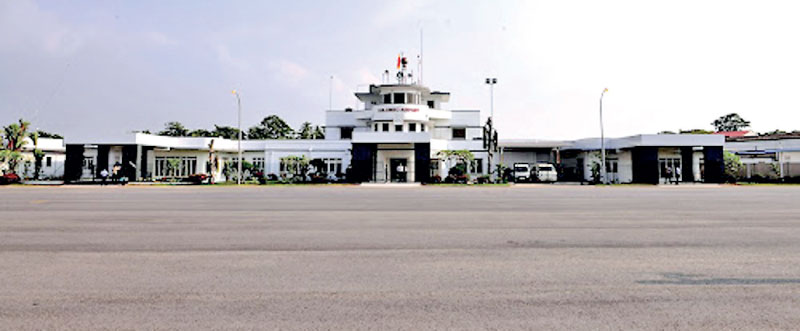Wednesday Mar 05, 2025
Wednesday Mar 05, 2025
Monday, 4 April 2022 01:00 - - {{hitsCtrl.values.hits}}

|
 Colombo Airport Ratmalana has started international flights after 54 years. Sadly no one gave thought to developing this vital asset. How many governments went past – maintaining perhaps one of our country’s most famous white elephants.
Colombo Airport Ratmalana has started international flights after 54 years. Sadly no one gave thought to developing this vital asset. How many governments went past – maintaining perhaps one of our country’s most famous white elephants.
The past 54 years has had several governments. All have acted with the same silence. The silence of development. Successive governments have failed to have a vision for the benefits and potential of smaller airports.
What is the benefit of the small airport? Regionally in Dubai, Singapore, Thailand, Malaysia 50% of arrivals is with budget airlines. We in Sri Lanka have 2.4 million visitors without a dependency on budget carriers – plausibly extending our potential by a further 50% if budget carriers are facilitated with efficiently run smaller airports.
A further potential increase in tourist arrivals by 2.4 million annually is not beyond imagination. A benefit of smaller airports is that check-in and check-out times are easy and fast. Smaller airports are virtually designed for budget airline operation. For airlines turnaround times are critical – as for such airlines more time in the air is critical for revenue.
Typically, turnaround time is maximum 25 minutes. Tickets are cheap – domestic workers using budget airlines will help save more money for the national economy. The Sri Lankan Government’s urgent requirement is to save foreign currency expenditure and the need to increase foreign currency earnings.
On the expectation that the Colombo Airport can receive 1,400 passengers daily – meaning 500,000 tourists annually – this translates to a billion-dollar revenue annually.
The target could well be a realistic 20 flights per day. The model of budget airlines regionally is a case in point: Dubai, Thailand, Malaysia, Indonesia, Singapore, India and the Maldives is in sharp focus. Maldives for example has a solo attraction: their beaches, whilst Sri Lanka offers more variety – beaches, wild life, the misty mountains, its tea trails, its rich cultural history, its world-recognised rain forest and its several monuments to past glories.
To fully realise the potential at Colombo Airport several matters need to be addressed. For example, an Airbus A-320 cannot land with the existing runway. To increase the runway on one end is near impossible due to the Bellanwila bird sanctuary and also the restricted space around Sri Lanka’s parliament. Operationally this would mean a hard right turn soon after take off but will that mean an incursion into the bird sanctuary area?
The alternative would be to embark on an up-scaling project from the Galle Road end towards what is now the Railway yards. The Galle road would need to go under the runway and the expenditure would be intense.
The existing possibility of limiting the Colombo Airport to smaller aircraft – carrying an average 50 seats per flight – will need some investment. Professionals from the aviation industry told me that they will need the most modern radar systems and a precision Instrument Landing System to be in place. Colombo Airport will need facilities in terms of safety that will appeal to other aviation regulators in order that approval will be granted to consider regular scheduled usage of Colombo Airport. The ILS was removed from this facility and taken to the world’s loneliest international airport, at Mattala. It will now need replacing anew.
|
Some archaic laws may also have to be shelved. Recently, night time flying bans were lifted by the local regulator. Nearly 13 years after the end of the terrorist problem in Sri Lanka, security clearances for the use of Colombo Airport can take months, claim stakeholders. Flying schools based at the facility have onerous regulatory requirements to fulfil – stymying their efforts to expand and offer a competitive regional advantage. Along with the modernisation of archaic laws there is a need for some of the regulations to be made easier without compromising safety. These would include a retake on the duty structure of spares and parts needed by the aviation industry.
A wall at the approach end of the runway has been ‘given’ to a welfare fund to earn revenue from advertising. This makes it perhaps the only airport in the world to have a wall on approach to a landing.
How many such white elephants await development? The Government has this goal: the question is ‘When’ will this be achieved. The need is for procrastination to be abandoned immediately.
Discover Kapruka, the leading online shopping platform in Sri Lanka, where you can conveniently send Gifts and Flowers to your loved ones for any event including Valentine ’s Day. Explore a wide range of popular Shopping Categories on Kapruka, including Toys, Groceries, Electronics, Birthday Cakes, Fruits, Chocolates, Flower Bouquets, Clothing, Watches, Lingerie, Gift Sets and Jewellery. Also if you’re interested in selling with Kapruka, Partner Central by Kapruka is the best solution to start with. Moreover, through Kapruka Global Shop, you can also enjoy the convenience of purchasing products from renowned platforms like Amazon and eBay and have them delivered to Sri Lanka.
Discover Kapruka, the leading online shopping platform in Sri Lanka, where you can conveniently send Gifts and Flowers to your loved ones for any event including Valentine ’s Day. Explore a wide range of popular Shopping Categories on Kapruka, including Toys, Groceries, Electronics, Birthday Cakes, Fruits, Chocolates, Flower Bouquets, Clothing, Watches, Lingerie, Gift Sets and Jewellery. Also if you’re interested in selling with Kapruka, Partner Central by Kapruka is the best solution to start with. Moreover, through Kapruka Global Shop, you can also enjoy the convenience of purchasing products from renowned platforms like Amazon and eBay and have them delivered to Sri Lanka.